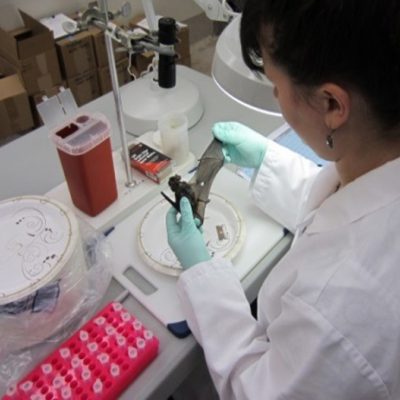by fourth-year DVM student Samantha Darling

Two summers ago, I was accepted to participate in the College’s Summer Research Program. I chose to devote my summer to research because I desire to pursue an anatomical pathology residency and PhD after graduation. This program seemed like an ideal opportunity to build valuable skills. I worked jointly with Dr. Steven Bolin’s Laboratory at DCPAH and the Michigan DNR Wildlife Disease Laboratory in order to determine the prevalence of Pseudogymnoascus destructans, the causative agent of white-nose syndrome, in Michigan bats.
Named for the white fungus that appears on the muzzle, white-nose syndrome is associated with extensive mortality of hibernating bats in eastern North America. Bats with white-nose syndrome act strangely during the winter, including flying outside during the day and clustering near the entrances of the caves where they hibernate. White-nose syndrome is estimated to have killed more than 6 million bats.
This month, our research on Pseudogymnoascus destructans was published by the Journal of Wildlife Diseases. This wonderful achievement would never have been possible had it not been for a seemingly insignificant occurrence during my undergraduate career at MSU.
During my junior year of undergrad in one of my zoology classes, I met Julie Melotti, a laboratory technician at the Michigan DNR Wildlife Disease Laboratory. I have always been interested in wildlife and so I asked if I could shadow her at work. The day I shadowed her, I witnessed necropsies being performed on many Michigan wildlife species and my interest in veterinary pathology was sparked. I became so interested that I began to assist Julie with her research project on parasites in the small intestine of Michigan’s coyote population. I continued to assist with this research project for the rest of my undergraduate career.
The relationships that I built with Julie and the rest of the staff at the Michigan DNR Wildlife Disease Laboratory were essential to my experience in the summer research program. Julie became one of my mentors for the program, as did Dr. Dan O’Brien. Because of them, I was also able to have Dr. Steven Bolin as my MSU faculty mentor during this experience.
My summer research project involved determining the prevalence of Pseudogymnoascus destructans in Michigan bats. It had just been discovered in Michigan the previous year, and seemed to be quickly spreading throughout the state. It was very exciting to be able to study such an important emerging wildlife disease. I spent many hours examining the muzzle, wings and tail membranes of over 1,000 dead bats under an ultraviolet light in hopes of detecting Pseudogymnoascus destructans. All of these bats had been submitted to the Michigan Department of Health and Human Services Laboratory from May 2014 to May 2015 as potential human and domestic animal exposures to rabies and had tested negative for the disease. I then collected a wing sample from each bat and performed DNA extraction and PCR on these tissue samples. A large portion of my summer was also devoted to researching white-nose syndrome and writing up my research findings.
Every step of the way, my mentors were there to lend me support and encouragement. As I had never worked in a research lab before, Dr. Bolin and his laboratory technologist, Ailam Lim, spent many hours in the lab with me teaching me how to perform DNA extraction and PCR on my bat wing samples. Dr. O’Brien and Julie spent many hours discussing white-nose syndrome with me, and all four of them spent a great deal of time reading and editing my final research paper. Over the course of this experience, I was deeply touched by the patience and kindness that was shown towards me by each one of them and also by their strong desire for me to succeed. I felt very blessed and grateful to have had such wonderful mentorship during this program.
While it is a great honor to have a research project that I was a part of be published so early in my veterinary career, the greater honor is to have had the opportunity to work with such kind and caring people in the veterinary community. I am so thankful that I was chosen by the CVM summer research committee to be a participant in their research program. This summer experience was extremely valuable to me in more ways than one. One day, I hope to pay it forward by providing the same type of mentorship that I received during my veterinary education to future veterinary students.
